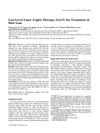Analysis of Mice Skin Distribution Using MALDI-MSI After Subcutaneous Injections of a New Potent Inhibitor of Human Hair Growth, FOL-005
August 2016
in “
Journal of Investigative Dermatology
”

TLDR Some men don't respond to common hair loss treatments, but a new inhibitor, FOL-005, shows promise for targeting unwanted hair growth.
The document summarizes several studies on hair loss treatments and their effects. One study showed that out of 92 men treated with Finasteride for androgenic alopecia, 23 did not respond, and of those, 16 treated with Dutasteride saw a 56.25% improvement rate after six months. Another study reported uncommon side effects of Finasteride in 102 patients, including severe depressive symptoms and vitiligo post-treatment. A third study found 42 differentially expressed microRNAs in hair follicles that may contribute to male pattern baldness in 25 healthy male donors. Additionally, a study of 68 men linked hand preference and sexual orientation to the distribution of Finasteride side effects. Lastly, a new hair growth inhibitor, FOL-005, was shown to be localized to treated skin areas and degraded locally, indicating its potential for clinical use against excessive hair growth. Another study demonstrated that a Rosebay extract could rebalance scalp microbiota and reduce dandruff and sebum in humans.






